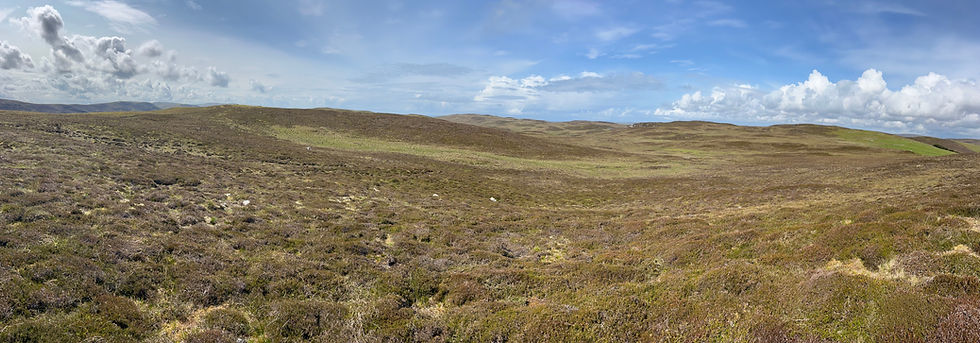Site in Focus - Ockran Burnt Mound and Bronze Age Roundhouse
- Stephen Jennings
- Oct 9, 2019
- 3 min read

Recently we revisited Ockran to record, clean and hope for some diagnostics on two new sites near Tingon in Northmavine – a possible burnt mound and Bronze Age roundhouse. It was an exciting prospect as we had noted the locations from an earlier fieldwalk at which time we chanced upon two potsherds at the entrance to a nearby rabbit burrow that were subsequently identified as late Bronze Age or early Iron Age. We further hoped a wider landscape survey might give us some sense of the size of the prehistoric field system and lead to other unrecorded sites in the vicinity. What we found was more than we hoped.
Beginning with the burnt mound, identification is based primarily on typology. We did find some evidence of fire-cracked stone though very little is currently exposed. The crescent-shaped mound rises approximately 2m from its base and measures 12m in length, 8m in width. Measuring along the spine of the crescent, we found it runs for 15.2m end to end. At the base of a steep slope, it is 50m north of a dry streambed. Discerning this aspect of the landscape in prehistory is difficult given the extensive and unfortunate modern land drainage as can be seen from the overview photograph of Ockran.
The roundhouse was a more complex site to untangle. Located on the east side of a small slope, the main structure has an interior wall measurement of 7.2m west to east, 6.4m north to south with a probable south facing entrance. The exterior wall ranges from a single line of stones on the north side due to robbing and/or erosion and 2m thick on the west side. It appears a portion of the wall thickness around the site is tumble. There are adjacent structures south and east but these show signs of modern disturbance, particularly on the east. There are large orthostatic stones scattered around, most notable are two stones 7m west and a single orthostat, much larger at nearly 1m tall, 5m south.
The wider landscape and field system are more difficult to parse through. Most of the immediate field walls that may be contemporary with the site can be picked up intermittently though are most visible to the east and the southwest. Quite irregular in nature, an approximation of maximum length is 135m and maximum width of 65m with the roundhouse situated in the northwest quadrant. Throughout the wider Ockran landscape there are orthostatic stones, walls, collapsed structures and additional, clear prehistoric walls. However, many of these are overlain by more modern structures (krubs, cairns, walls) or may require full excavation to identify. Undoubtedly some will prove also to be prehistoric in origin.
Returning to the roundhouse, it was here where some diagnostic clues revealed themselves. The first was an agglomerate artefact found at the base of the large orthostat to the south (see photograph below). Resembling a broken ard point, it also had the appearance of being used as a hammerstone, probably post breakage. Unlikely to be an ard point – it shows none of the typical wear and is untypical of the type of stone used as such – the tool it may have originally been is unclear.
From here we conducted a clean and record of the north wall which had been robbed out and/or eroded. Immediately a potsherd revealed itself. Carefully extracting it, we ceased cleaning at this point to preserve the integrity of the site. The context in which it was found was between the two large stones to the right of the ranging rod in the photograph below. These forming the structural fabric of the interior wall, it was approximately 25cm above the base of the stones.
This potsherd is unlike the two that were originally found at a rabbit burrow some 20m to the west. Whilst these showed clear use, the sooty grain of the outside contrasting nicely with the smooth grain of the inside, the potsherd from the wall was coarser with larger inclusions. Moreover, the outside was exceptionally rough with no signs of decoration or corded interior. It is also thinner, 8mm as opposed to 10mm. With that said, we recognise that its appearance is similar in colour to the earlier sherds and in neither case do we know the type of vessel or from which part the sherds may have come. Yet at the least, it has allowed us to feel fairly confident that the structure has an origin in the Bronze Age, perhaps late.
We found more than we originally hoped as it is not often we have diagnostic finds on a simple clean and record.

























Comments